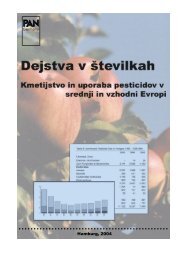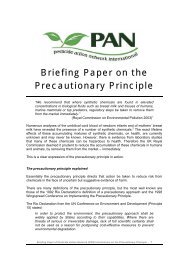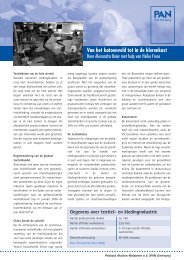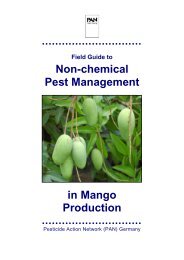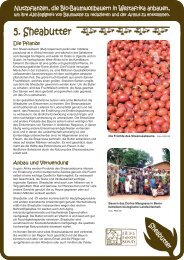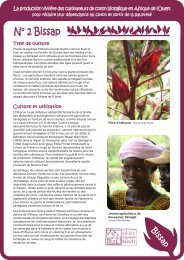Field Guide: How to Grow Crops without Paraquat - Online ...
Field Guide: How to Grow Crops without Paraquat - Online ...
Field Guide: How to Grow Crops without Paraquat - Online ...
You also want an ePaper? Increase the reach of your titles
YUMPU automatically turns print PDFs into web optimized ePapers that Google loves.
<strong>Field</strong> <strong>Guide</strong>: <strong>How</strong> <strong>to</strong> Live and Work Without <strong>Paraquat</strong><br />
Pigweeds<br />
Scientific name: Amaranthus spp.<br />
head is composed of closely-packed clusters of small<br />
purplish or green flowers. Sharp spines are present at<br />
the leaf nodes and at the base of the flower head,<br />
hence the name.<br />
4. Smooth pigweed (A. hybridus)<br />
The stem has small fine hairs and green or reddishpurple<br />
at maturity. The flower head has more<br />
branches that are compacted and much longer than<br />
the other species. It also has the green or reddishpurple<br />
color at maturity.<br />
5. Waterhemp (A. rudis)<br />
The stem is smooth, <strong>without</strong> hairs and erect. Its color<br />
varies from light-green <strong>to</strong> dark-red with multiple<br />
shades, sometimes on the same plant. The leaves are<br />
smooth, glossy, long and narrow, and somewhat<br />
rounded. It is not easy <strong>to</strong> identify the various amaranth<br />
species. Ask for assistance from your local agricultural<br />
offices or from weed experts.<br />
Redroot pigweed<br />
Habitat<br />
Dry, disturbed ground, especially cultivated or<br />
abandoned fields, and burned areas<br />
Affected crops<br />
Almost all agricultural crops<br />
Distribution<br />
Worldwide<br />
Description<br />
Important pigweed species<br />
1. Redroot pigweed (A. retroflexus) Other names:<br />
Careless weed, Common amaranth, Common<br />
pigweed, Rough pigweed, Pigweed<br />
The stem is round with white longitudinal veins, lightgreen,<br />
and covered with light fine hairs. The leaves<br />
are diamond-shaped, rough, and reddish-green. The<br />
flower head is branched, tall, and is composed of very<br />
small greenish-white <strong>to</strong> green flowers. The weed has a<br />
pinkish <strong>to</strong> red taproot, hence one of its known common<br />
names.<br />
2. Livid amaranth (A. lividus, A. blitum) Other names:<br />
Purple amaranth, Slender amaranth<br />
The stem is erect or ascending and has reddish or<br />
yellowish coloration. The leaves are ovate and<br />
smooth. The flowers are green in tight clusters,<br />
located at the end of the branch<br />
3. Spiny amaranth (A. spinosus) Other name: Thorny<br />
pigweed<br />
The stem is s<strong>to</strong>ut, fleshy, smooth, and reddish. The<br />
leaves are simple and arranged alternately and often<br />
have v-shaped variegation (coloration). The flower<br />
Effects and impacts<br />
The weed is an alternate host for beet armyworm and<br />
other insects, nema<strong>to</strong>des, and viral diseases. It can<br />
reduce yield by up <strong>to</strong> 40% on corn and soybean if not<br />
properly controlled. The plant is edible and has<br />
medical value. The leaves are eaten raw or cooked.<br />
The whole plant is used <strong>to</strong> cure wounds. Seed oil is<br />
used as an ointment for burns, rashes, and acnes.<br />
Several studies show that most amaranth species are<br />
resistant <strong>to</strong> most herbicides. Livid amaranth is found <strong>to</strong><br />
be resistant <strong>to</strong> Atrazine on some corn fields in France;<br />
<strong>to</strong> <strong>Paraquat</strong> on vegetables in Penang, Malaysia; and<br />
<strong>to</strong> Imazethapyr on cabbage, lettuce, and onion in New<br />
Jersey, USA. Redroot pigweeds are found <strong>to</strong> be<br />
resistant <strong>to</strong> Atrazine, Metribuzin, Diuron, Linuron,<br />
Simazine, Imazaquin, Cyanazine on some asparagus,<br />
corn, pota<strong>to</strong> farms, croplands, orchards, and vineyards<br />
in some parts of China, Europe, and USA. Smooth<br />
pigweed is found <strong>to</strong> be resistant <strong>to</strong> Atrazine on some<br />
corn farms and croplands in France, Israel, Italy,<br />
Spain, and South Africa; <strong>to</strong> Simazine in some<br />
vegetables areas in Switzerland; and <strong>to</strong> Chlorimuronethyl,<br />
Imazamox, Thifensulfuron-methyl, and Imazethapyr<br />
on corn, soybean, vegetables, and croplands in<br />
some states of US. Waterhemp is found <strong>to</strong> be resistant<br />
<strong>to</strong> Atrazine, and Imazethapyr on soybean in Canada;<br />
<strong>to</strong> Acifluorfen-Na, Atrazine, Fomesafen, Imazamox,<br />
Lac<strong>to</strong>fen, Chlorimuron-ethyl, Imazethapyr, and Thifensulfuron-methyl<br />
on alfalfa, corn, grain sorghum,<br />
soybean, and croplands in some states of US.<br />
Methods of control<br />
1. Proper selection of seeds<br />
2. Thorough land preparation by plowing and<br />
harrowing at least two times<br />
3. Regular plant moni<strong>to</strong>ring<br />
4. Proper weed management<br />
•••••••••••••••••••••••••••••••••••••••••••••••••••<br />
24 Pesticide Action Network (PAN) Germany



